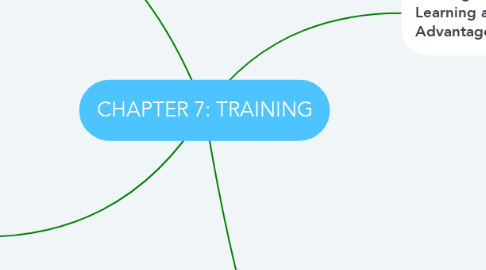
1. Evaluating Training Programs
1.1. Training outcomes; can be categorized as cognitive outcomes, skill-based outcomes, affective outcomes, results, and return on investment, the types of outcomes used in evaluating training programs and what is measured and how it is measured.
1.2. Evaluation Designs
1.3. Determining the Financial Benefits of Learning
2. Special Training Issues
2.1. CROSS-CULTURAL PREPARATION
2.1.1. 1. Competent in their areas of expertise 2. Able to communicate verbally and nonverbally in the host country 3. Flexible, tolerant of ambiguity, and sensitive to cultural differences 4. Motivated to succeed; able to enjoy the challenge of working in other countries; and willing to learn about the host country’s culture, language, and customs 5. Supported by their families
2.2. MANAGING WORKFORCE DIVERSITY AND INCLUSION
2.2.1. The process of creating an environment that allows all employees to contribute to organizational goals and experience personal growth.
2.3. ONBOARDING OR SOCIALIZATION
2.3.1. Onboarding, or socialization, refers to the process of helping new hires adjust to social and performance aspects of their new jobs.117 This process is important to help employees adjust to their jobs by establishing relationships to increase satisfaction; clarifying goals and expectations to improve performance; and providing feedback, coaching, and follow-up activities to reduce turnover
3. Training: Its Role in Continuous Learning and Competitive Advantage
3.1. Training: refers to a planned effort by a company to facilitate employees’ learning of job-related competencies, knowledge, skills, and behaviors. The goal of training is for employees to master the knowledge, skills, and behaviors emphasized in training and apply them to their day-to-day activities
3.2. Formal training: refers to training and development programs, courses, and events that are developed and organized by the company
3.3. Informal learning refers to learning that is learner initiated, involves action and doing, is motivated by an intent to develop, and does not occur in a formal learning setting. Informal learning: occurs without an instructor, and its breadth, depth, and timing are controlled by the employee
3.4. Explicit knowledge: refers to knowledge that is well documented, easily articulated, and easily transferred from person to person. Examples of explicit knowledge include processes, checklists, flowcharts, formulas, and definitions. Explicit knowledge: tends to be the primary focus of formal training
3.5. Tacit knowledge: refers to personal knowledge based on individual experiences that make it difficult to codify. It is best acquired through informal learning
3.6. Knowledge management: refers to the process of enhancing company performance by designing and implementing tools, processes, systems, structures, and cultures to improve the creation, sharing, and use of knowledge. Knowledge management: contributes to informal learning
4. Designing Effective Formal Training Activities
4.1. NEEDS ASSESSMENT
4.1.1. refers to the process used to determine if training is necessary. Figure 7.3 shows the causes and outcomes resulting from needs assessment
4.1.1.1. Organizational Analysis
4.1.1.1.1. process for determining appropriateness of training by evaluating characteristics of the organization
4.1.1.2. Person Analysis
4.1.1.2.1. process of determining individuals’ needs and readiness for training by answering three questions: 1.Do performance deficiencies result from a lack of knowledge, skill, or ability? 2.Who needs training? 3.Are these employees ready for training?
4.1.1.3. Task Analysis
4.1.1.3.1. process of identifying and analyzing tasks to be trained. To carry out task analysis: •Job’s equipment and environment •Time constraints •Safety considerations •Performance standards
4.2. Learning management system (LMS):
4.2.1. a computer application that automates the administration, development, and delivery of training programs.
4.2.1.1. training needs
4.2.1.2. training outcomes
4.2.1.3. associated rewards
4.3. Selecting training method
4.3.1. Presentation Methods
4.3.2. Hands-on Methods
4.3.3. Group or Team-Building Methods

